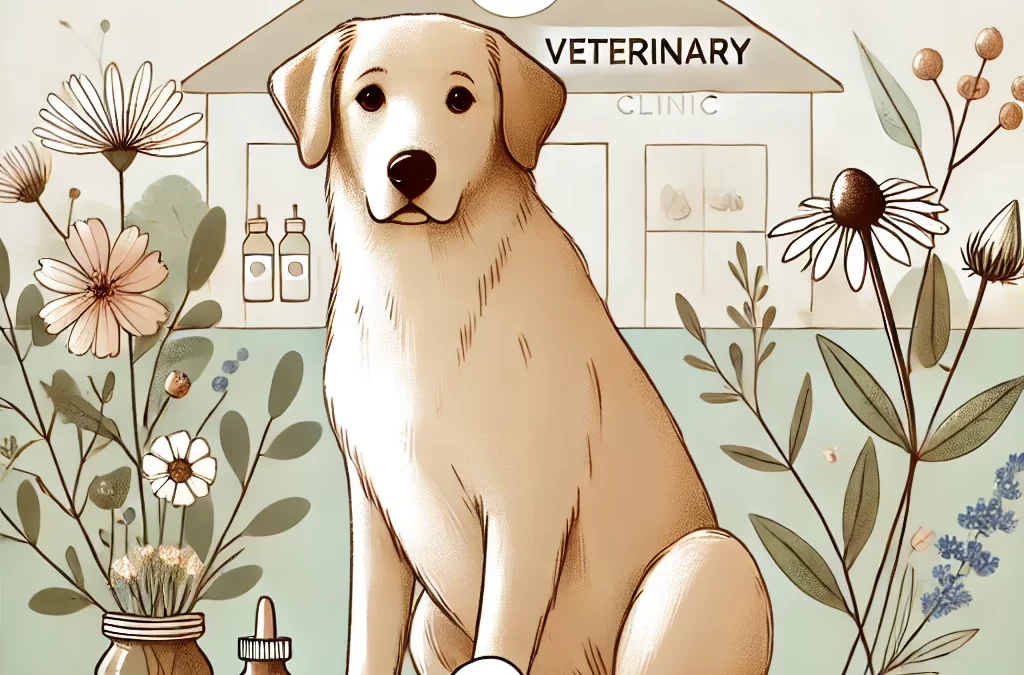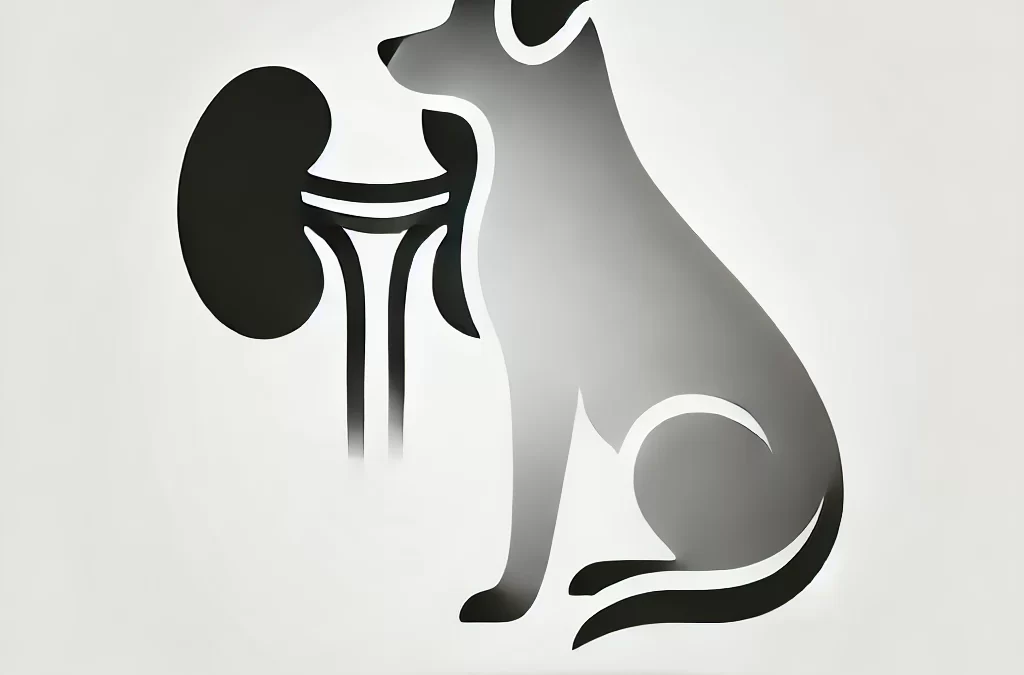
by TCMVET | Dec 3, 2024 | Dog Cancer & Tumors
Hemangiopericytoma is a rare soft tissue tumor in dogs, arising from pericytes, the cells surrounding blood vessels. While these tumors are generally slow-growing and localized, their tendency to recur after surgical removal makes them a unique challenge in veterinary oncology. This article delves into the nature of hemangiopericytomas, their diagnosis, and groundbreaking ways to manage them effectively.
What is Hemangiopericytoma in Dogs?
Hemangiopericytomas are typically found in the skin or subcutaneous tissues of middle-aged to older dogs. These tumors may appear as:
- Firm, movable lumps under the skin
- Masses varying in size, sometimes ulcerated if on the surface
- Slow-progressing but invasive growths
Commonly located on limbs, these tumors rarely metastasize but can significantly impact a dog’s mobility and comfort.
Uncommon Signs to Watch For
While hemangiopericytomas might initially seem harmless, certain symptoms should raise concern:
- Persistent licking or biting of a lump
- Swelling that doesn’t resolve
- Localized lameness or discomfort
These subtle signs often precede more obvious indications of a growing tumor.
Innovative Approaches to Diagnosis
Traditional diagnostic methods involve fine-needle aspiration or biopsy, followed by imaging like X-rays or ultrasounds. However, advancements in veterinary diagnostics now allow for:
- CT Scans: Providing detailed images of the tumor’s extent.
- 3D Tumor Modeling: Used to plan precise surgical interventions.
- Liquid Biopsies: A cutting-edge method to detect tumor-specific markers in the bloodstream, offering non-invasive monitoring.
Rethinking Treatment Options
While surgery remains the gold standard for hemangiopericytoma treatment, innovative methods are emerging to enhance outcomes:
- Advanced Surgical Techniques: Laser surgery and electrosurgery reduce the risk of recurrence by achieving cleaner margins.
- Immunotherapy: Stimulating the immune system to target residual cancer cells post-surgery.
- Cryotherapy: Freezing tumor cells for localized control when surgery is not viable.
- Photodynamic Therapy: Using light-activated drugs to destroy cancer cells.
These novel approaches provide alternatives for cases where traditional surgery might be challenging or insufficient.
Natural and Supportive Therapies
Holistic care is gaining traction as a complement to conventional treatments. These include:
- Herbal Supplements: Ingredients like astragalus and medicinal mushrooms support immunity and potentially inhibit tumor growth.
- Acupuncture: Helps alleviate pain and improve overall wellbeing.
- CBD Oil: Renowned for its anti-inflammatory and analgesic properties, it can help dogs cope with discomfort.
Combined with proper nutrition and regular exercise, these therapies contribute to improved quality of life.
The Power of Palliative Care
For dogs with advanced or recurrent hemangiopericytomas, palliative care focuses on comfort:
- Pain management with medications or laser therapy
- Mobility aids like harnesses or wheelchairs
- Emotional enrichment to maintain mental health
Owners often find solace in knowing they’re providing their pets with love and care during challenging times.
Why Hemangiopericytomas Are a Call for Innovation
Hemangiopericytomas challenge veterinarians and pet owners alike to think beyond conventional treatments. The low metastatic potential provides a unique opportunity to experiment with targeted therapies and holistic approaches without compromising the dog’s quality of life.
By embracing emerging technologies and integrative care, the management of hemangiopericytomas can evolve into a more personalized and effective process, giving dogs the best chance at a comfortable and fulfilling life.

by TCMVET | Dec 3, 2024 | Dog Cancer & Tumors
Spinal cancer in dogs is a rare but critical condition that affects the backbone or spinal cord, potentially leading to debilitating symptoms. While traditional veterinary approaches often involve surgery, radiation, or chemotherapy, there’s a growing movement towards integrative and natural therapies that prioritize quality of life. This article explores the unique challenges of spinal cancer in dogs and introduces alternative perspectives on management.
What is Spinal Cancer in Dogs?
Spinal cancer occurs when abnormal cells grow uncontrollably in the spine, affecting bones, nerves, or surrounding tissues. Common types include:
- Osteosarcoma: Affects the bones of the spine.
- Lymphoma: May infiltrate the spinal cord or vertebrae.
- Neoplasms: Tumors pressing on the spinal cord or nerves.
These tumors may cause pain, difficulty walking, paralysis, or incontinence, depending on their location.
Uncommon Symptoms to Watch For
Early signs of spinal cancer are often subtle and may mimic other conditions:
- Shifting weight or favoring one side while walking
- Change in posture, such as an arched back
- Sensitivity to touch along the spine
These indicators, though not definitive, warrant immediate veterinary attention.
Rethinking Diagnosis and Prognosis
Conventional diagnostic methods like X-rays, MRIs, and biopsies can confirm the presence of spinal cancer, but they are invasive and costly. In some cases, the prognosis can be grim, leading many pet owners to seek less invasive and more holistic approaches. Understanding a dog’s specific condition, overall health, and quality of life is essential in determining the best path forward.
Integrative and Natural Approaches
Innovative approaches are gaining traction among pet owners and veterinarians looking to complement or replace traditional treatments. These include:
- Acupuncture: Helps manage pain and improve nerve function.
- Herbal Remedies: Ingredients like turmeric and boswellia may reduce inflammation and slow tumor growth.
- CBD Oil: Gaining popularity for its pain-relieving and anti-inflammatory properties.
When combined with proper nutrition, moderate exercise, and a stress-free environment, these therapies can greatly enhance a dog’s comfort and wellbeing.
The Power of Palliative Care
For dogs with advanced spinal cancer, palliative care focuses on managing symptoms rather than curing the disease. This includes:
- Medications to reduce pain and inflammation
- Physical therapy to improve mobility
- Emotional support to maintain a strong bond with your pet
Many pet owners find that prioritizing comfort over aggressive treatment results in a happier, more peaceful life for their furry companions.
Hope for Dogs with Spinal Cancer
While a diagnosis of spinal cancer is daunting, it doesn’t have to mean the end of hope. By exploring alternative therapies and focusing on quality of life, pet owners can provide their dogs with the love and care they deserve. Each dog’s journey is unique, and a thoughtful approach can make all the difference.
by TCMVET | Dec 2, 2024 | Dog Cancer & Tumors
Osteosarcoma is a common yet aggressive bone cancer in dogs, often associated with severe pain and lameness. However, heavy breathing is a less-discussed symptom that can appear in advanced cases, leaving many pet owners confused and concerned. This article explores the potential reasons behind heavy breathing in dogs with osteosarcoma and offers guidance for managing this troubling symptom.
Why Does Heavy Breathing Occur?
Dogs with osteosarcoma may experience heavy breathing for several reasons, including:
1. Pain and Discomfort
Osteosarcoma is a painful condition, especially when the tumor grows or metastasizes. Pain can lead to increased respiratory rates as the body struggles to manage stress. Heavy breathing in this context is often a sign of discomfort.
2. Metastasis to the Lungs
In advanced stages, osteosarcoma frequently spreads to the lungs. Pulmonary metastases can cause breathing difficulties, coughing, or wheezing due to reduced lung capacity and oxygen exchange.
3. Side Effects of Pain Medication
Many dogs with osteosarcoma are prescribed pain relief medications, such as opioids or nonsteroidal anti-inflammatory drugs (NSAIDs). These medications, while necessary, can sometimes affect respiratory patterns.
4. Anxiety or Stress
Chronic pain and the emotional impact of illness can make a dog anxious, leading to panting or heavy breathing. Dogs often use their breath as a way to communicate distress.
5. Secondary Complications
Conditions such as pleural effusion (fluid around the lungs) or anemia from chronic illness can also contribute to labored breathing. Both issues can arise as secondary complications of osteosarcoma or its treatment.
When to Be Concerned
Heavy breathing should not be ignored, especially if it is accompanied by:
- Lethargy or unwillingness to move.
- Coughing or wheezing.
- Blue-tinged gums or tongue, indicating low oxygen levels.
- Rapid deterioration in overall health.
These symptoms may signal an urgent need for veterinary intervention.
What Can Be Done to Help?
1. Pain Management
Effective pain control is essential. Consult your veterinarian about adjusting medications or incorporating alternative therapies like acupuncture or CBD oil to reduce discomfort.
2. Oxygen Therapy
In cases of lung metastases or pleural effusion, supplemental oxygen can help ease breathing. Portable oxygen chambers or in-clinic treatments may provide relief.
3. Monitor Stress Levels
Create a calm and comfortable environment for your dog. Use gentle massages, calming pheromones, or prescribed anxiety medications to reduce stress.
4. Palliative Care
If your dog’s condition is advanced, palliative care may focus on maintaining quality of life. This could involve managing symptoms rather than pursuing aggressive treatments.
5. Veterinary Evaluation
Always consult a veterinarian if heavy breathing persists or worsens. Diagnostic tests, including chest X-rays and blood work, can help identify underlying causes.
A Compassionate Approach
Heavy breathing in a dog with osteosarcoma is a reminder of the physical and emotional toll this disease takes. While the condition is challenging to manage, a combination of medical care, love, and attentiveness can provide comfort. Always work closely with your veterinarian to make the best decisions for your dog’s well-being.
By recognizing and addressing heavy breathing promptly, you can help ensure your dog feels supported and cared for, even in the most trying times.

by TCMVET | Dec 2, 2024 | Dog Cancer & Tumors
Kidney cancer in dogs is a relatively rare condition, but its subtle symptoms can often be mistaken for other ailments, delaying crucial treatment. This article dives into the lesser-known signs of this silent disease, helping dog owners identify potential issues before it’s too late.
A Rare but Serious Condition
Kidney cancer accounts for less than 1% of all cancers in dogs, yet its impact on a dog’s health can be profound. While older dogs are more commonly affected, no breed is immune. Unlike cancers with visible growths or obvious symptoms, kidney cancer often remains hidden until it reaches an advanced stage.
Unmasking the Symptoms
Here are some surprising symptoms of kidney cancer that pet owners might overlook:
1. Increased Thirst and Urination (Polydipsia and Polyuria)
One of the earliest signs is excessive thirst and urination, which are often dismissed as signs of aging or a kidney infection. However, these symptoms could indicate the kidneys’ struggle to function due to a tumor.
2. Blood in the Urine (Hematuria)
Spotting red or pink-tinged urine can be alarming. Hematuria is a red flag for kidney problems, including kidney cancer. The bleeding may come and go, making it easy to miss during casual observation.
3. Unexplained Weight Loss
A dog losing weight without any changes to diet or activity levels may be experiencing systemic effects of kidney cancer. The tumor can interfere with appetite and nutrient absorption, leading to gradual weight loss.
4. Abdominal Swelling
Swelling or a palpable mass in the abdomen is a more advanced symptom. Owners might notice their dog’s belly feels firmer or looks larger than usual.
5. Decreased Energy Levels
Lethargy is a common yet nonspecific symptom of many illnesses, including kidney cancer. Dogs with this condition may show a noticeable decline in activity and enthusiasm for play.
6. Vomiting and Digestive Issues
As the kidneys fail to filter toxins effectively, gastrointestinal symptoms like vomiting, nausea, and diarrhea can appear. These symptoms might intensify over time.
7. Difficulty Breathing
In rare cases, kidney cancer can metastasize to the lungs, causing labored breathing or coughing.
Why Early Detection Matters
Early diagnosis is key to improving outcomes for dogs with kidney cancer. Treatments, including surgery to remove the affected kidney (nephrectomy), chemotherapy, or holistic approaches, are more effective when the disease is caught early.
What Can Pet Owners Do?
1. Regular Vet Checkups
Routine health exams can detect abnormalities that might otherwise go unnoticed. A thorough physical examination, combined with blood and urine tests, can provide early clues about kidney health.
2. Know Your Dog’s Norm
Observing subtle changes in your dog’s behavior, appetite, and urinary habits can be lifesaving. Keeping a health diary can help track unusual symptoms over time.
3. Embrace Diagnostic Tools
If kidney cancer is suspected, advanced diagnostic tools like ultrasounds, X-rays, or CT scans can confirm the presence of tumors and guide treatment.
A Hopeful Future
While kidney cancer is a serious diagnosis, advances in veterinary medicine provide hope. Beyond conventional treatments, some dog owners explore complementary therapies, such as herbal supplements or dietary changes, to support their dog’s overall health.
Closing Thoughts
Kidney cancer in dogs may be rare, but understanding its symptoms can save lives. By staying informed and vigilant, pet owners can ensure their furry friends live healthier, longer lives. If you notice any of these signs, don’t wait—consult your veterinarian immediately. Early action is the best defense against this silent disease.

by TCMVET | Nov 30, 2024 | Dog Cancer & Tumors
When it comes to our furry companions, nothing is more heart-wrenching than the diagnosis of a mammary mass. The very word “mass” strikes fear, conjuring images of cancer and invasive treatments. But what if there was more to mammary mass removal in dogs than just the surgical procedure? What if the healing process could encompass not only the physical act of removing the mass but also embrace a holistic, integrative approach that promotes true wellness?
In this article, we’ll explore how mammary mass removal is evolving, pushing the boundaries of conventional veterinary medicine to offer a comprehensive solution for dogs facing this condition.
The Mammary Mass Mystery: Understanding the Basics
Mammary masses are relatively common in female dogs, especially those that have not been spayed. While many masses are benign, some may be malignant, leading to a higher concern for cancer. In fact, approximately 50% of mammary tumors in dogs are cancerous, making early detection and prompt treatment vital.
Traditionally, the primary treatment for mammary masses has been surgical removal, often followed by chemotherapy or radiation if the mass is found to be malignant. This approach is still widely used, but with a growing interest in alternative and complementary therapies, the scope of treatment has expanded.
Surgery: A Foundation, Not the Whole Solution
Surgical removal remains the cornerstone of mammary mass treatment. The goal is to excise the mass completely, reducing the risk of the cancer spreading. However, the act of surgery alone does not guarantee long-term health. The real work begins after the incision has healed.
It’s here that an integrative approach comes into play.
Integrating Holistic Care: The Power of Prevention and Support
While surgery addresses the immediate physical concern, what many dog owners are now discovering is that post-operative care can be just as important in slowing recurrence and promoting overall health. The role of diet, lifestyle, and natural therapies is coming to the forefront as essential components of recovery.
1. Diet and Nutrition: Fueling the Body’s Defenses
Post-surgery, a balanced diet becomes crucial. Research suggests that certain nutrients can support immune function and help fight off cancerous cells. Omega-3 fatty acids (found in fish oil) have anti-inflammatory properties, while antioxidants (such as vitamins C and E) can protect healthy cells from oxidative stress.
Some experts even recommend a raw food diet or an anti-cancer diet for dogs with a history of mammary tumors. These diets emphasize lean meats, vegetables, and herbs that may help strengthen the dog’s immune system and reduce inflammation.
2. Herbal Supplements and Natural Remedies: A Holistic Touch
In addition to conventional treatments, many holistic veterinarians advocate for herbal supplements that can aid in healing. Adaptogenic herbs like ashwagandha or turmeric are known for their anti-inflammatory and immune-boosting properties. Additionally, lignans, found in flax seeds, are often recommended for their potential to inhibit the growth of cancer cells.
These natural remedies can be used alongside traditional treatments to help balance the body’s systems and improve overall vitality.
3. Mind-Body Connection: Stress Reduction and Emotional Healing
A dog’s emotional well-being should not be underestimated in the healing process. Research increasingly supports the idea that stress, anxiety, and negative emotions can affect the body’s ability to recover from illness. Offering a calm, loving environment with plenty of rest and affection can help reduce your dog’s stress levels, allowing their body to heal more effectively.
Massage therapy, gentle exercise, and even canine acupuncture are also being explored as ways to promote circulation, reduce pain, and encourage overall wellness during recovery.
Early Detection and Proactive Care: Prevention is Key
Prevention of future mammary masses or recurrence hinges on early detection. Regular vet check-ups, along with routine mammary gland exams (either during grooming or through veterinary visits), can help catch abnormalities early. For dogs at higher risk—those who haven’t been spayed or have had previous tumors—owners should be vigilant and proactive about any changes in the mammary glands.
In addition, spaying before the first heat cycle has been shown to reduce the risk of mammary tumors in dogs, making it an important consideration for pet owners.
What’s Next? The Future of Mammary Mass Treatment
As veterinary care continues to evolve, the approach to mammary mass removal is becoming increasingly multifaceted. While surgery remains a critical tool, it is no longer the sole focus of treatment. The integration of holistic care practices, early detection, and preventative measures offer a more comprehensive strategy to combat mammary masses and promote overall health in dogs.
By embracing a well-rounded approach that nurtures both the body and the mind, we can ensure that our furry friends have the best chance at a long, healthy, and happy life after mammary mass removal.
Key Takeaways
- Surgery remains essential for mammary mass removal but should be followed by supportive care.
- Diet plays a pivotal role in recovery, with anti-inflammatory and immune-boosting foods helping the healing process.
- Holistic therapies, including herbal remedies and acupuncture, can enhance recovery and overall health.
- Stress reduction and emotional well-being are key components of the healing process.
- Early detection and spaying are crucial for preventing mammary masses and cancers in the future.
By thinking beyond the scalpel and embracing a holistic approach, we give our dogs not only the best chance at recovery but also a path to a richer, fuller life.




